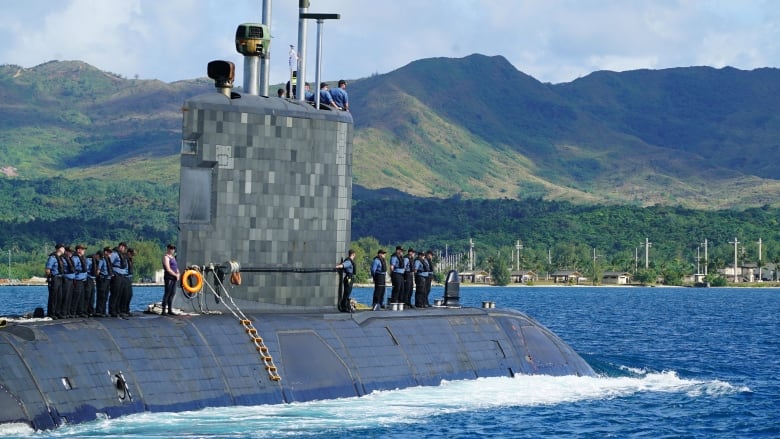Canadian sub on mission to bolster North Korea surveillance
'We are operating much more than any Canadian thinks,' HMCS Chicoutimi captain says

The last time HMCS Chicoutimi crossed an ocean, the boat flooded, caught fire, and a sailor died. Nearly a decade and a half later, the diesel-electric submarine has deployed to Asia — farther from home than any Canadian sub in five decades — on a mission the Canadian military hopes will erase doubts about the vessel's effectiveness.
Though planned for more than a year, the mission comes at a particularly sensitive time.
North Korea's nuclear and missile development activity has spiked in recent months despite trade sanctions. International tensions have risen to the point where the U.S. is considering options that could include a military strike on the Korean Peninsula.
- Gallery: Aboard the Chicoutimi on a mission in Asia-Pacific waters
- 360 video: In the control room of HMCS Chicoutimi
- 360 video: On the deck of the Chicoutimi at sea
"Our stealth is something we need to guard," says Cmdr. Stephane Ouellet, Chicoutimi's Commanding Officer, referring to the specifics of the current mission. "[But] we are operating much more than any Canadian thinks … deployed for almost 200 days and farther than we've ever operated before."
It took five weeks for the boat to travel from its home base in Esquimalt, B.C., to its classified patrolling area, making port visits in Japan and Guam.

Ouellet confirms the sub is capable of discreetly recording events on land, such as airport take-offs and landings. Its primary role revolves around tracking merchant and military vessels while submerged, and observing suspicious activity on the sea, including ship-to-ship cargo transfers far from any harbour.
That kind of capability is key in the region right now. The U.S. has accused China and Russia of breaching UN sanctions on North Korea by transferring oil from their ships to North Korean tankers out at sea to avoid detection.
At the end of January, Japan's military identified a Dominican-flagged tanker transferring oil to a North Korean vessel, for example.

But tracking illegal activity is difficult, especially in remote expanses of ocean.
Satellites only pass over an area intermittently, sometimes just once a day, and surface ships can scare off illicit activity.
That's where the submarine plays a vital role, watching areas of concern or specific targets around the clock.
According to Chicoutimi's combat officer, Lt. David Hendry, "whatever ship or object we're observing, they're unaware of the fact that we're there. And that is a huge bonus, because [then] they're not going to stop what they're doing."

New kind of mission
HMCS Chicoutimi was one of four mothballed subs bought used from the United Kingdom in the 1990s.
What was thought to be a sweetheart deal led to years of problems, starting with the 2004 fire aboard Chicoutimi when it first left the U.K. for Canada.
- Rebuilt HMCS Chicoutimi returns to Canadian navy
- Wonky welds keep West Coast submarines stuck in port
- Submarine HMCS Windsor shore bound after engine failure
In the years since, rust and welding issues have continued to plague the fleet, which has either been in dry dock, or sailing with limited capabilities.
Today, the situation has improved and a sub is always operating on both the Atlantic and Pacific coasts, including missions to identify illegal fishing or environmental crimes by vessels in Canadian waters.
During the chase, the Captain announced to his 58-person crew: "We are sneaking up on the warship now … at this point, I suspect he doesn't know where we are."
The sub used sonar to track the vessel and raised one of its two periscopes above the waves for visual confirmation, though for only seconds at a time to avoid being seen.
The Canadian boat followed a French frigate for more than two hours before surfacing less than a kilometre from the vessel. The Captain used codenames (Chicoutimi was "Ice Wine") over a secure radio to warn the warship just prior to surfacing. Until that point, the ship's crew was unaware how close the Canadian sub had been.
For security reasons, the crew could not discuss any other specific interceptions it has been involved with in recent weeks in the region.
Life aboard a sub
Aspects of the Chicoutimi's mission are shrouded in secrecy, but the 58 people aboard have little privacy themselves.
Sleeping quarters amount to a bunk, often embedded in another piece of equipment to save space. More than a dozen sleep above, below, or immediately beside the boat's Mark 48 torpedoes, for example.
Only the Captain has his own quarters, a tiny compartment adjacent to the noisy control room, where steering, navigation and sonar functions are staffed.
The crewmembers normally work eight hours on duty, eight off, then four hours on and four off. But everyone is called on duty when the submarine is diving, surfacing, tracking another vessel, or dealing with an emergency onboard.
The problem couldn't be fixed at sea, so the Chicoutimi put in at a nearby port for repair.

In spite of the minor setback, the Royal Canadian Navy has high hopes for this mission. After years of problems, Chicoutimi's far-flung deployment is intended to send a signal to allies — and Canadians — that the submarines can now go anywhere they're needed.
